Let's get straight to the point: How much can a smart thermostat actually save you on your energy bills? Most homeowners see a reduction of about 8-12% on their heating and a solid 15% on cooling costs every year.
These aren't just one-time savings. They come from smart features that learn your routine and trim energy use without you even noticing, turning that initial purchase into a reliable return, year after year.
Understanding Your Potential Savings
While the savings are real, the exact dollar amount you'll see depends entirely on your home and lifestyle. No two houses are the same. Think about it—an older, drafty home in a place with harsh winters is a completely different beast than a newer, well-insulated house in a mild climate.
This is why you can't just fixate on one magic number. Your family's schedule is just as important. Are you all out of the house for work and school during the day? Or is someone usually home? The answers directly influence how much a smart thermostat can dial back your HVAC system and save you money.
Key Factors Influencing Your Savings
So, what are the big variables that determine how much you'll save? It boils down to a few key things:
- Climate Zone: If you live somewhere with blistering summers or freezing winters, your HVAC system works overtime. That means a smart thermostat has a much bigger opportunity to cut down on run time and save you more.
- Home Insulation: Got an older home? You probably have some drafty windows or less-than-perfect insulation. While that's not great for efficiency, it does mean a smart thermostat can make a huge impact by preventing your system from constantly fighting to keep up with escaping air. A good way to find these problem areas is by doing a simple home energy audit.
- Household Schedule: The more predictable your routine is—especially if the house is empty for long stretches—the more an intelligent thermostat can do its job. It'll automatically lower the temperature when you're gone and have it perfectly comfortable right when you walk back in the door.
Even the U.S. Environmental Protection Agency backs this up. According to their ENERGY STAR program, certified smart thermostats save the average family about 8% on their heating and cooling costs, which shakes out to around $50 a year. If you want to dig into their research, you can explore the ENERGY STAR program details on their official site.
Estimated Annual Smart Thermostat Energy Savings
To give you a clearer picture, let's look at how savings can differ based on your climate and home size. The numbers below are estimates, but they show how these factors come into play.
| Climate Region | Small Home (Under 1500 sq ft) | Medium Home (1500-2500 sq ft) | Large Home (Over 2500 sq ft) |
|---|---|---|---|
| Cold Climate | $60 – $100 | $100 – $160 | $160 – $250 |
| Mixed Climate | $40 – $70 | $70 – $110 | $110 – $180 |
| Hot Climate | $50 – $90 | $90 – $140 | $140 – $220 |
As you can see, a larger home in a more extreme climate stands to gain the most, but every situation shows a clear benefit. These figures help set a realistic baseline for what you might expect.
Key Takeaway: Your potential savings are a unique mix of your home's physical traits and your family's daily life. Knowing this helps you set realistic goals for what a smart thermostat can do for your wallet.
Ultimately, by taking a quick look at these factors, you can get a much better idea of how a smart thermostat will perform for you and start making more informed choices about your home's energy use.
How Smart Thermostats Outsmart Energy Waste
So, what’s the real secret behind the significant smart thermostat energy savings people talk about? It’s not magic—it's just smart technology acting like a dedicated energy manager for your home. These gadgets do way more than just follow a basic program; they use a whole suite of features to slash waste without you ever feeling uncomfortable. They literally learn how you live and adapt to it.
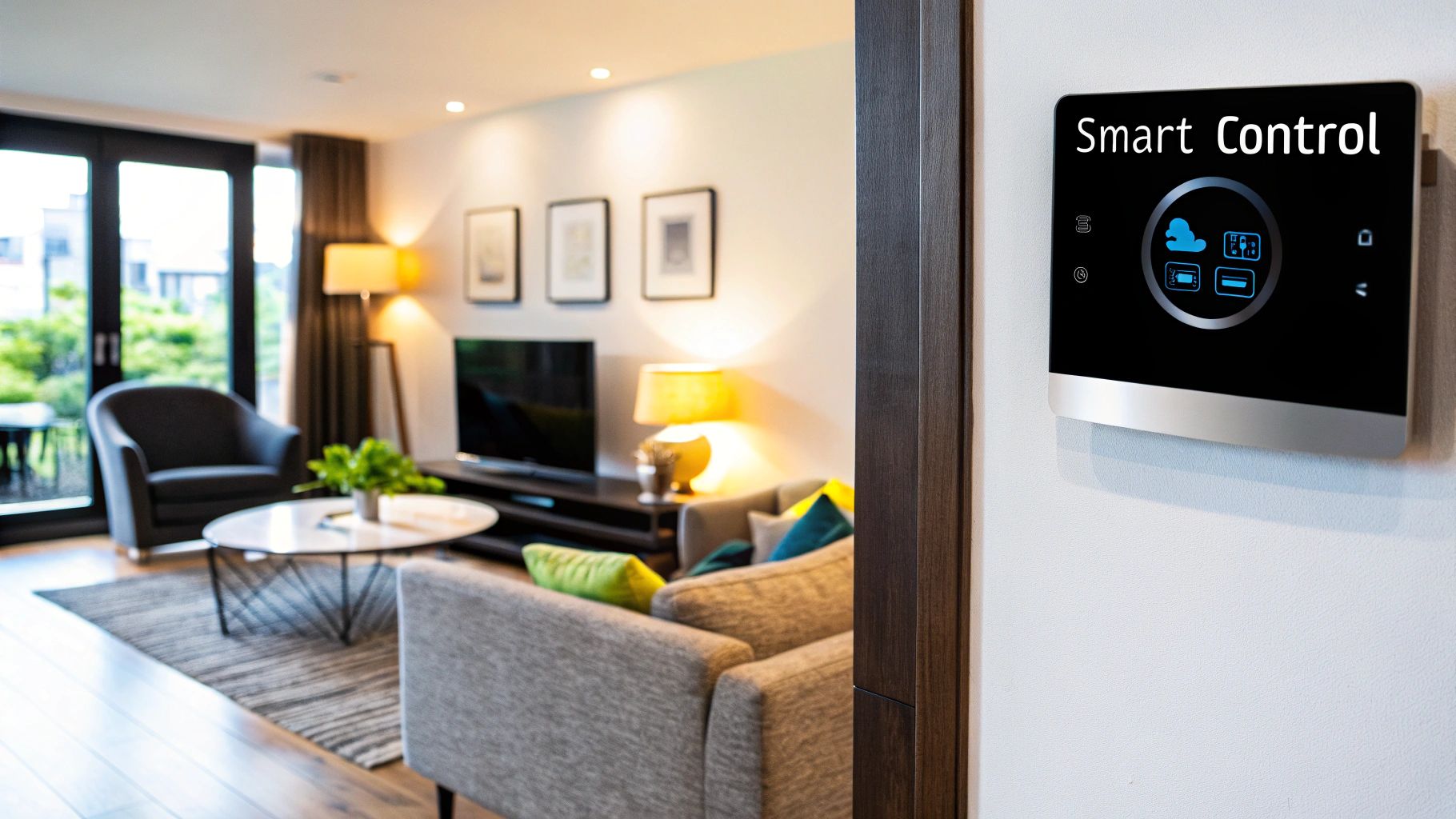
A regular thermostat just blindly follows the schedule you punch in. A smart one actually learns. This is the core of what makes them so effective. By figuring out when your HVAC system actually needs to kick on, it stops your furnace or AC from running when it doesn't have to, saving you money and reducing wear and tear.
The Power of Adaptive Learning
Think of your old thermostat like a cheap alarm clock. It goes off at the same time every single day, whether you're there to hear it or not. A smart thermostat with adaptive learning is more like a personal assistant who has your schedule memorized.
When you first set it up, you give it a starting point. But right away, it starts watching. It logs when you leave for work, when you get home, and every little manual adjustment you make. After a week or two, it pieces together a custom schedule that mirrors your real life, not just a rigid, pre-programmed guess. This is where the real savings begin.
For instance, if it notices you consistently lower the heat on weekend mornings when you're out running errands, it will just start doing it for you. This kind of hands-off fine-tuning makes sure your house is comfortable when you're home and in energy-saving mode when you're not.
This intelligent scheduling is more than just a cool feature; it's a direct line to a smaller energy bill. By taking the guesswork out of the equation, the thermostat ensures your HVAC system only runs when it truly has to.
Geofencing Knows When You Come and Go
Another fantastic tool in the smart thermostat's arsenal is geofencing. In simple terms, it uses your phone's GPS to create an invisible fence around your house. When your phone crosses that line, it tells the thermostat whether you're home or away.
- Leaving Home: The moment the last person's phone leaves the "fence," the thermostat automatically kicks into an energy-saving "Away" mode. No one has to remember a thing.
- Returning Home: As you drive back into your neighborhood and cross that boundary, it signals your HVAC to start bringing the house back to your preferred temperature. It's perfectly comfortable by the time you walk through the door.
This feature completely automates one of the biggest energy-saving habits people often forget: setting the thermostat back. It prevents hours of pointless heating or cooling every single week, which adds up to some serious cash saved over the year. For more ideas on creating an automated and efficient living space, check out our guide on building an energy-efficient smart home.
Turning Smart Features Into Maximum Savings
Just plugging in a smart thermostat and calling it a day is only half the battle. The real savings kick in when you start fine-tuning the settings to match your life. This is where you go from having a cool gadget on the wall to unlocking real, tangible dollars off your utility bills.
Think of it like teaching a new assistant the rhythm of your household. You need to show it when to be on high alert for comfort and when it can relax to save energy, like when everyone's at work or tucked in for the night.
Mastering Your Smart Schedule
The scheduling feature is your absolute powerhouse for savings. Forget the old "set it and forget it" mentality of manual thermostats. Now you can create a daily and weekly plan that perfectly mirrors what’s actually happening in your home.
A great way to start is by setting up three core temperature profiles: home, away, and sleep.
For instance, you might love it at a cozy 70°F when you're watching a movie, but you can let the temperature climb to 78°F in the summer when no one's around. At night, dropping the heat a few degrees while you’re under the covers is an easy win. The companion apps for these devices make setting this up surprisingly simple.
Here's a powerful little tip: just setting back the temperature for eight hours a day—say, while you're at work or asleep—can slash your annual heating and cooling costs by up to 10%. That's a huge return for such a small, hands-off adjustment.
Many thermostats also have a simple "eco mode" or a little green leaf icon. Toggling this on lets the thermostat automatically nudge the temperature a degree or two toward a more efficient setting. It's an effortless way to boost savings without even thinking about it. And if you're looking to connect your thermostat to a broader system, our smart home hub comparison can walk you through the options.
Interpreting Your Energy Reports
One of the most eye-opening features you'll get is the detailed energy report. Think of it as your home's energy scorecard. These reports break down precisely when your HVAC system ran, for how long, and how your adjustments impacted its usage day by day, week by week.
This example from ENERGY STAR gives you a sense of how clearly these devices can visualize your consumption, making it easy to manage.
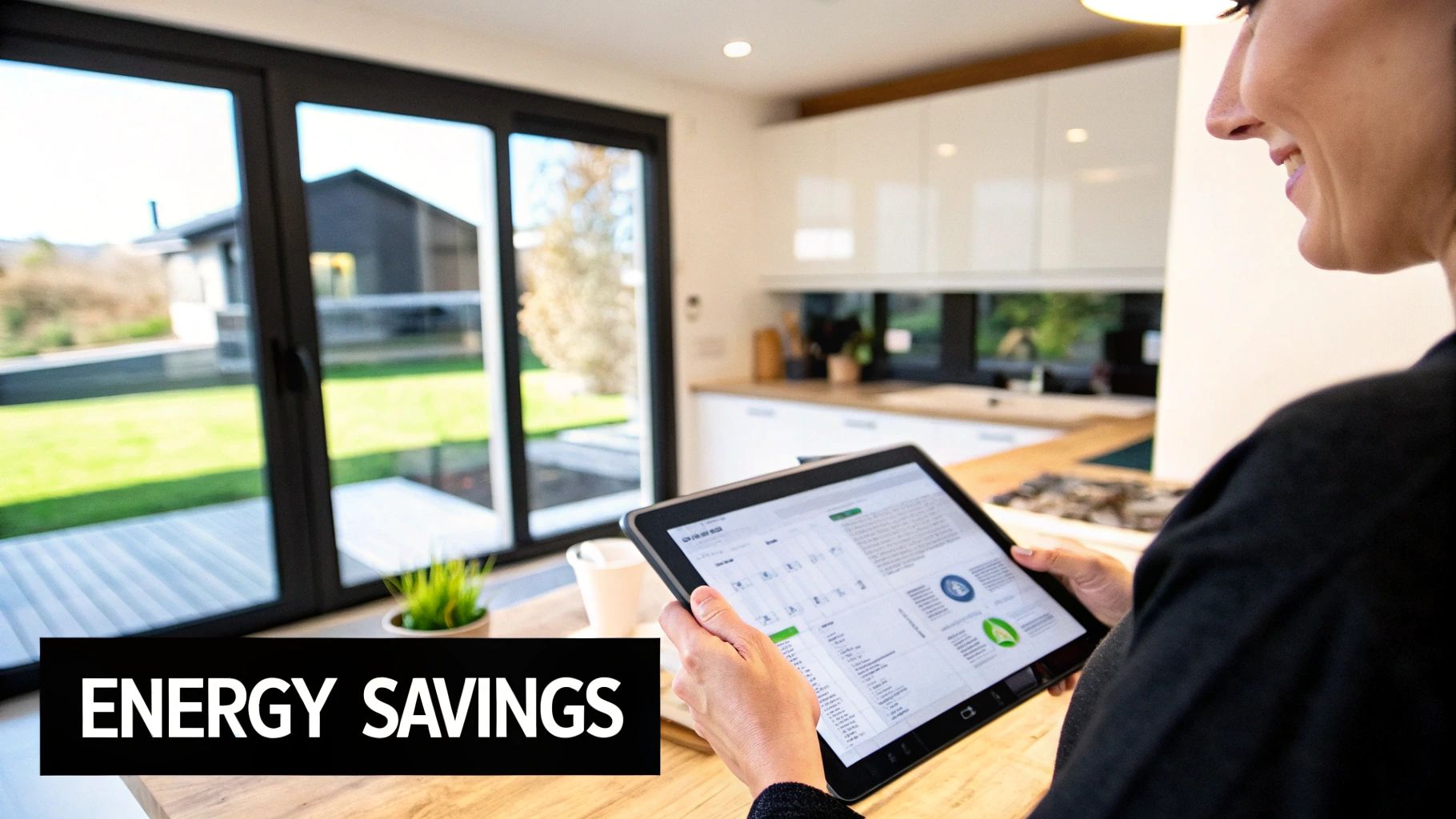
This isn't just data for data's sake; it's your roadmap to finding even more savings.
By checking in on these reports every so often, you start to see patterns. Maybe you'll notice a huge energy spike on weekend afternoons and realize you can create a specific "Saturday Sports" setting when the family is out. It’s this constant feedback loop—see the data, make a tweak, see the results—that truly transforms a smart device into an intelligent home energy manager.
Calculating Your Return on Investment
Let's get down to brass tacks. The technology is cool, but does a smart thermostat actually make financial sense? It all boils down to one thing: your return on investment, or ROI. This isn't some complicated financial formula; it's just a straightforward comparison of what you spend upfront versus what you'll save down the road on your energy bills.
To figure this out, you first need to know your total initial cost. This is more than just the price tag on the thermostat itself. You'll need to account for any professional installation fees if you're not comfortable doing it yourself. Once you have that number, you can start looking at potential savings. The easiest way to get a ballpark figure is to dig up your old utility bills and apply the average savings percentages we've already covered.
Unpacking the Payback Period
I'll be honest, a smart thermostat costs more upfront—usually two to three times more than a basic model. But here's the good news: they almost always pay for themselves within 1 to 3 years thanks to the money you save on heating and cooling.
Even better, you can often shrink that timeline significantly. Many utility companies and government programs offer rebates of $50 to $100 for upgrading. Grabbing a rebate through a program like ENERGY STAR can shorten your payback period by as much as 40%. It’s a crucial part of understanding how energy management shapes your spending.
The infographic below breaks down exactly where those savings come from. As you can see, the real magic happens when the thermostat starts to learn your habits.
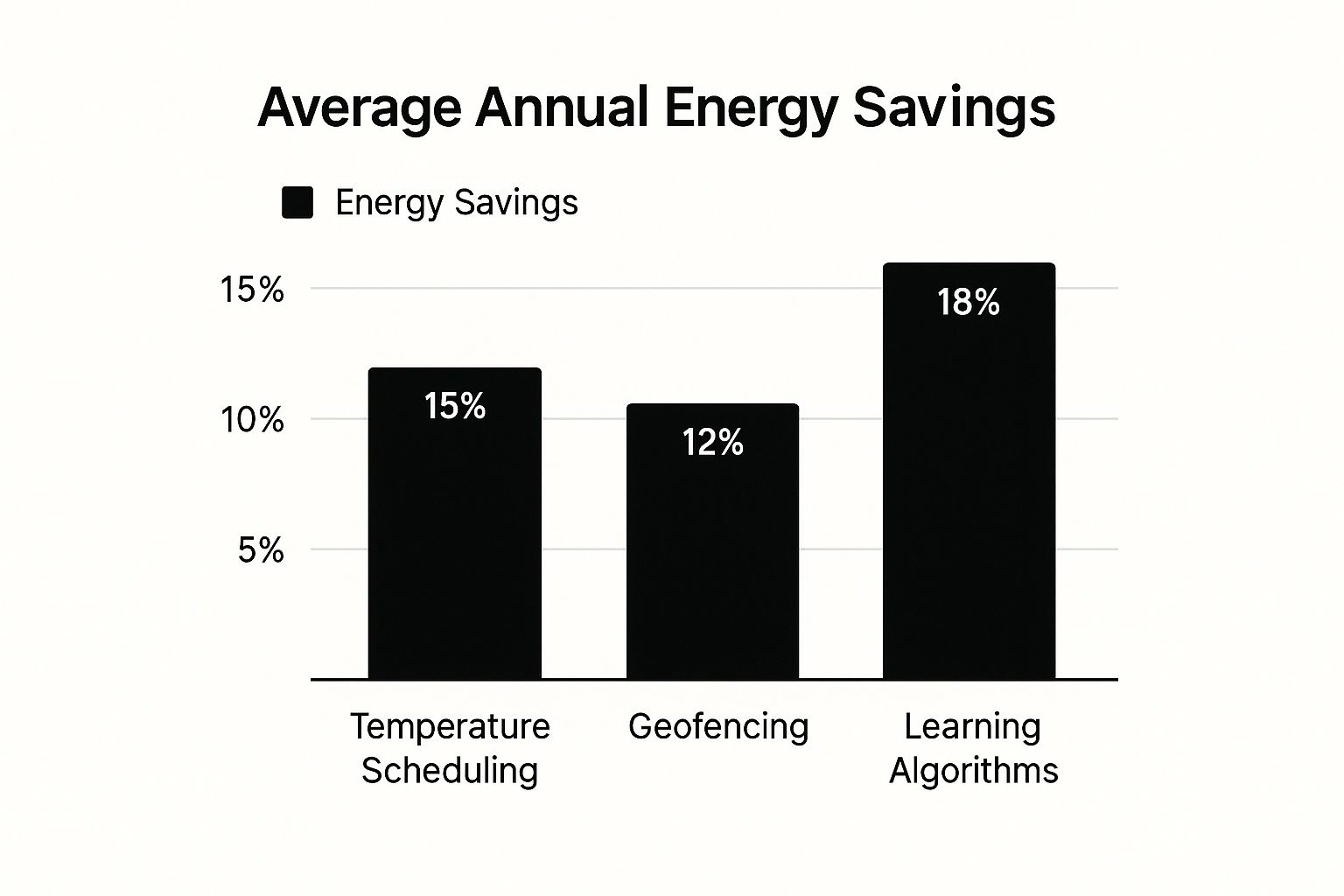
This shows that the device’s ability to adapt to your life is what really drives the financial return. It's not just about setting a simple schedule.
By layering intelligent scheduling, geofencing, and adaptive learning, a smart thermostat creates a powerful system for cutting energy use. This ensures your investment starts paying you back as quickly as possible.
To give you a clearer picture, I've put together a simple table comparing how the payback period changes based on the thermostat's price and a common rebate amount.
Smart Thermostat Payback Period Comparison
| Thermostat Price Tier | Initial Cost | Estimated Annual Savings | Payback Period (Without Rebates) | Payback Period (With $75 Rebate) |
|---|---|---|---|---|
| Budget Model | $130 | $145 | ~11 months | ~5 months |
| Mid-Range Model | $180 | $145 | ~1.25 years | ~9 months |
| Premium Model | $250 | $145 | ~1.7 years | ~1.2 years |
As the table shows, even a premium model becomes much more affordable with a simple rebate, turning into a money-saving asset in just over a year.
Let’s walk through one of those scenarios.
- Initial Cost: You buy a mid-range model for $180 and install it yourself.
- Utility Rebate: You get a -$75 rebate from your local power company.
- Net Cost: Your actual out-of-pocket cost is now just $105.
- Estimated Annual Savings: You save an average of $145 per year.
In this very realistic situation, your smart thermostat pays for itself in about 9 months. After that, it’s pure savings. This quick turnaround is exactly why they've become such a popular and practical home upgrade.
Real Stories of Smart Thermostat Success
The data is one thing, but where the rubber really meets the road is in how these devices solve real-world problems for actual people. Forget the idea that these are just gadgets for tech enthusiasts. They're practical tools that fit right into the messy, unpredictable flow of modern life.
Let's walk through a few scenarios where a smart thermostat goes from a neat gadget to the unsung hero of the household budget.
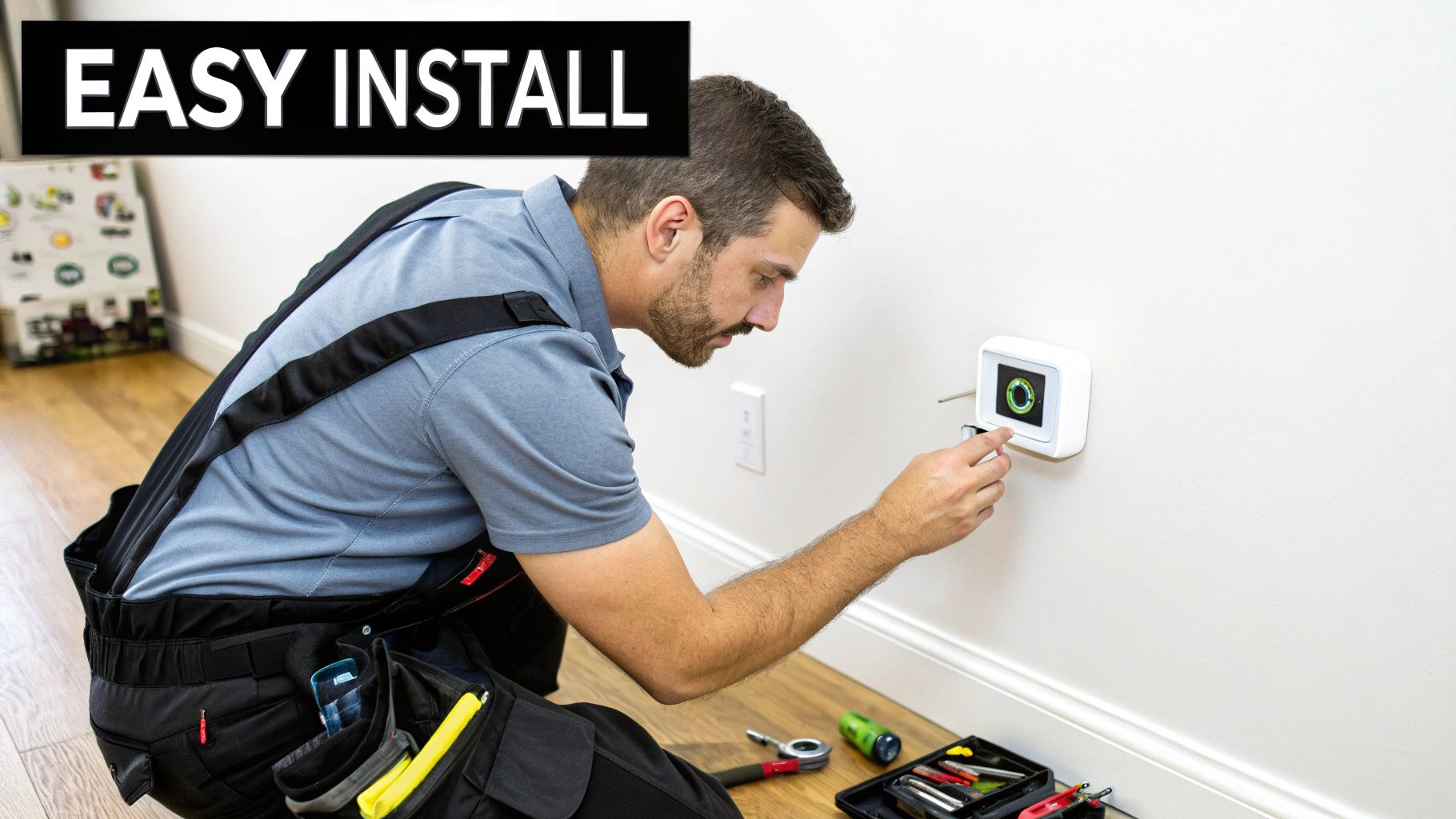
The Busy Family with a Chaotic Schedule
Picture a family with two working parents and kids bouncing between school, sports, and friends' houses. Their daily schedule is a moving target. One day everyone's home by 5 PM, but the next they’re out late for a soccer game. A standard programmable thermostat just can't keep up with that kind of chaos. They were constantly either paying to heat an empty house or walking into a cold one.
This is where a smart thermostat’s learning algorithm shines. It quickly adapted to their comings and goings, using geofencing to sense when the last person left and when someone was on their way back. Suddenly, the house was comfortable the moment they walked in, but never a minute before. That first winter, they saw their heating bill drop by a solid 12%.
The Frequent Traveler on the Go
Now think about someone like Alex, a consultant who travels for work a few times a month. In the past, every trip involved a last-minute scramble to remember to turn the heat down. More often than not, in the rush to the airport, it got forgotten. The result? Days of paying to heat an empty home.
With a smart thermostat, Alex can manage everything from a smartphone. A quick tap in the airport lounge sets the system to an energy-saving away mode. If an unexpected cold front moves in back home, Alex can even nudge the heat up a few degrees to be safe, all from hundreds of miles away. It’s about more than just savings; it’s about peace of mind.
Smart thermostats bridge the gap between intention and action. They automate the energy-saving habits we know we should have but often forget in the chaos of daily life, turning good intentions into actual dollars saved.
The Couple in a Harsh Climate
Finally, let's look at a retired couple living somewhere with blistering summers and freezing winters. Their top priority is staying comfortable, but running the HVAC full-blast year-round led to some truly eye-watering utility bills.
They used their smart thermostat to build a schedule that perfectly matched their daily routine. The system now pre-cools the house in the early morning before peak electricity rates kick in. During the hottest part of the afternoon when they’re usually relaxing, it lets the temperature drift up just a few degrees. This simple strategy keeps them perfectly comfortable while side-stepping the most expensive energy periods, proving you don't have to choose between comfort and cost.
Beyond Your Wallet: The Bigger Picture of Smart Energy
While the money you save is a fantastic perk, installing a smart thermostat has an impact that stretches far beyond your own home. The real power of smart thermostat energy savings comes alive when thousands—and eventually millions—of us are all making smarter choices together. This collective action helps build a more reliable and efficient energy grid for everyone.
Think of the electrical grid as a busy highway. During rush hour—say, a blazing hot summer afternoon or a freezing winter morning—it gets completely jammed with traffic, or in this case, energy demand. This congestion forces utility companies to fire up extra "peaker" plants. These are often the most expensive and least efficient power sources, brought online just to prevent blackouts.
Stabilizing the Grid Together
This is where smart thermostats come in as a surprisingly simple, yet powerful, solution. Many utility companies now have voluntary programs that allow your thermostat to make tiny, automatic temperature adjustments during these high-demand periods. You likely won't even notice the change.
By shifting energy use just a degree or two across a huge number of homes, these programs take a massive amount of strain off the grid.
When your thermostat participates in a demand-response event, it’s doing more than just saving you money. It's actively helping to prevent power outages and keep energy costs lower for the entire community.
This coordinated effort is quickly becoming a key part of modern energy management. It’s a perfect example of how our individual choices at home can add up to create a more stable and efficient system for all.
The Growing Movement of Smart Energy
This isn't just a niche trend; it's a massive, worldwide shift toward smarter energy use. The smart thermostat market tells the story perfectly.
Valued at roughly $5.04 billion in 2024, the market is expected to skyrocket to $27.61 billion by 2034. North America is leading the charge with a 40% market share, thanks to a growing awareness of both the financial and environmental upsides. You can dig deeper into these numbers with these market growth insights.
Widespread adoption is what makes this so effective. Every new smart thermostat connected to the grid strengthens our collective power to manage energy intelligently. Your investment is more than just a home upgrade—it's a vote for a more sustainable energy future.
Answering Your Smart Thermostat Questions
It's totally normal to have a few lingering questions, even when the benefits seem clear. Any time you're making a change to your home's core systems, a little bit of hesitation is natural. Let's walk through some of the most common concerns we hear from people thinking about making the switch.
We'll tackle these questions head-on so you can feel completely confident about your decision.
Will It Work with My Old HVAC System?
This is probably the number one question people ask, and for good reason! The good news is that compatibility is rarely an issue. Most smart thermostats are designed from the ground up to work with a massive range of HVAC systems, even much older ones.
Whether you have a furnace, central air conditioning, or a heat pump, there's almost certainly a smart thermostat that can hook right up. The best way to be 100% sure is to use the manufacturer's compatibility checker tool right on their website. You'll answer a few quick questions about your current wiring, and it'll tell you instantly if the model you're looking at is a match.
Do I Really Need a C-Wire for Installation?
Ah, the infamous "C-wire." The C-wire (or "common wire") is what provides a constant stream of power to a smart thermostat, which it needs for its Wi-Fi connection and bright screen. Your old thermostat didn't need this, so not every home has one.
But don't let that stop you. If you find you don't have a C-wire, you've still got simple options. Many smart thermostats now include a power adapter kit in the box. These clever little devices let the thermostat draw consistent power using your existing wires, completely avoiding the need to call an electrician to run a new one. Just make sure to check the product details to see if a kit is included.
Key Insight: The C-wire question shouldn't be a dealbreaker. With power adapter kits and other simple workarounds, most homes can accommodate a smart thermostat without major electrical work.
How Accurately Can It Learn My Routine?
This is where the magic behind smart thermostat energy savings really happens. These devices are incredibly good at learning your habits. For the first week or two, the thermostat pays close attention—it notes when you turn the temperature up or down and uses its sensors to figure out when you're home and when you're away.
From there, it builds a surprisingly accurate schedule that reflects your actual life. It doesn't just guess; it combines your direct input with real-world sensor data to create a predictive schedule that keeps you comfortable while cutting waste. And it never stops learning. The longer you have it, the more data it gathers, constantly fine-tuning its schedule to maximize both your comfort and your savings.
Ready to take control of your home's energy use? Explore more guides and find the perfect smart home solutions at Automated Home Guide. Visit us at https://automatedhomeguide.com to get started.
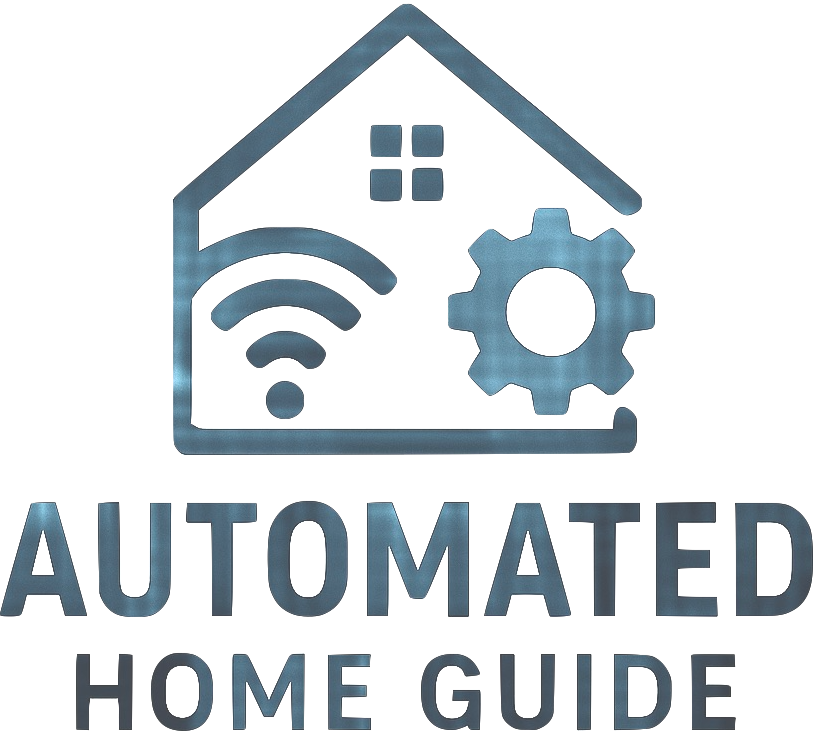
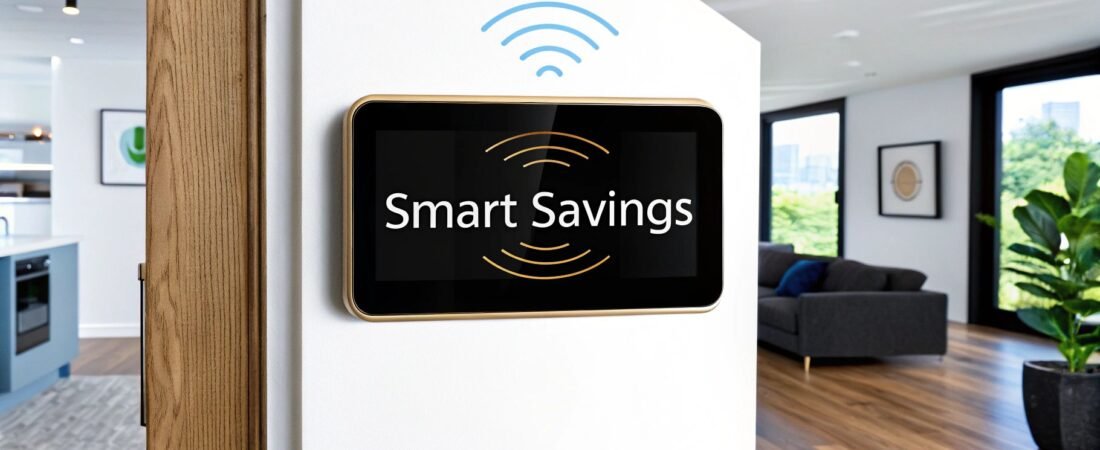
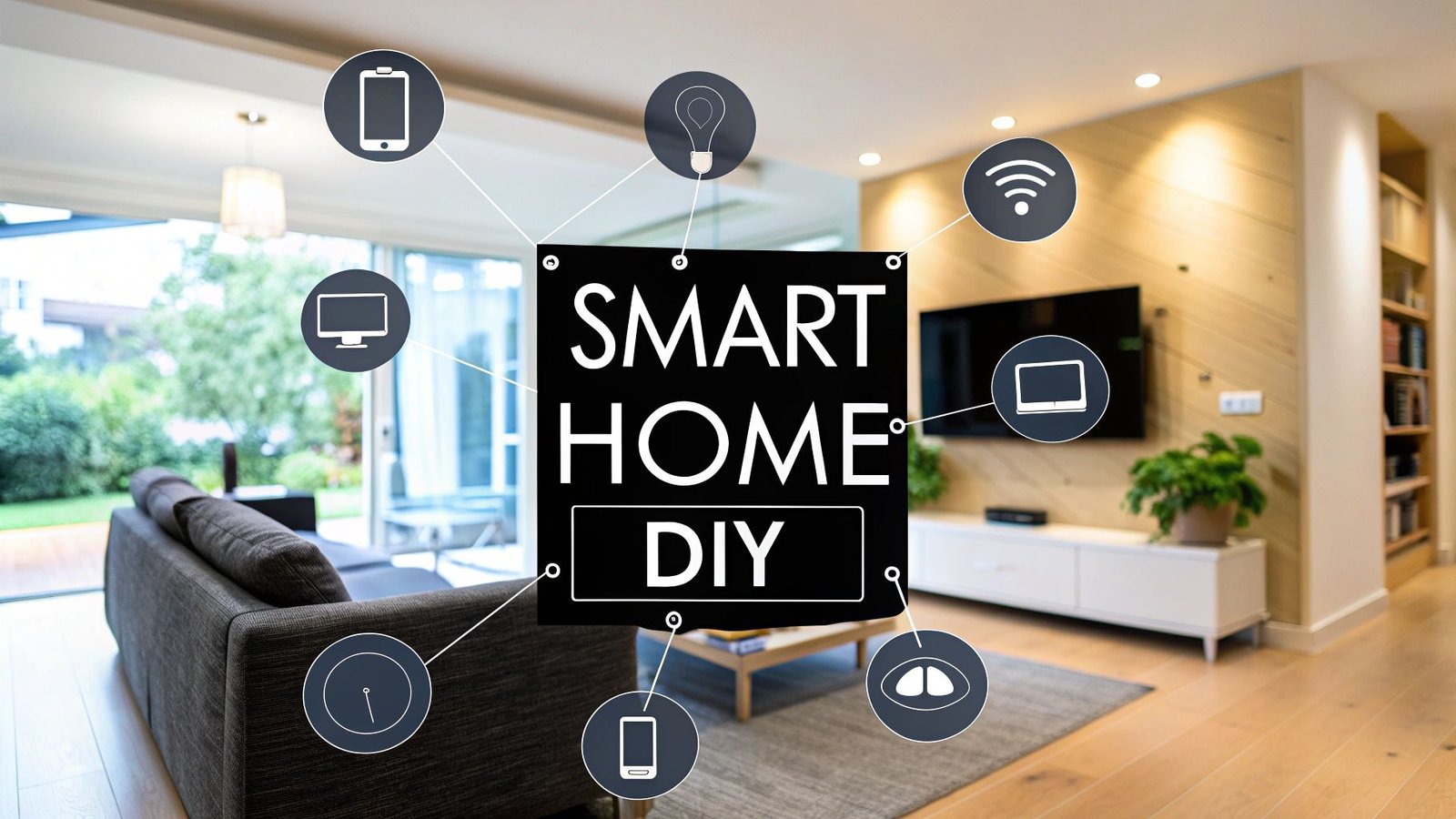
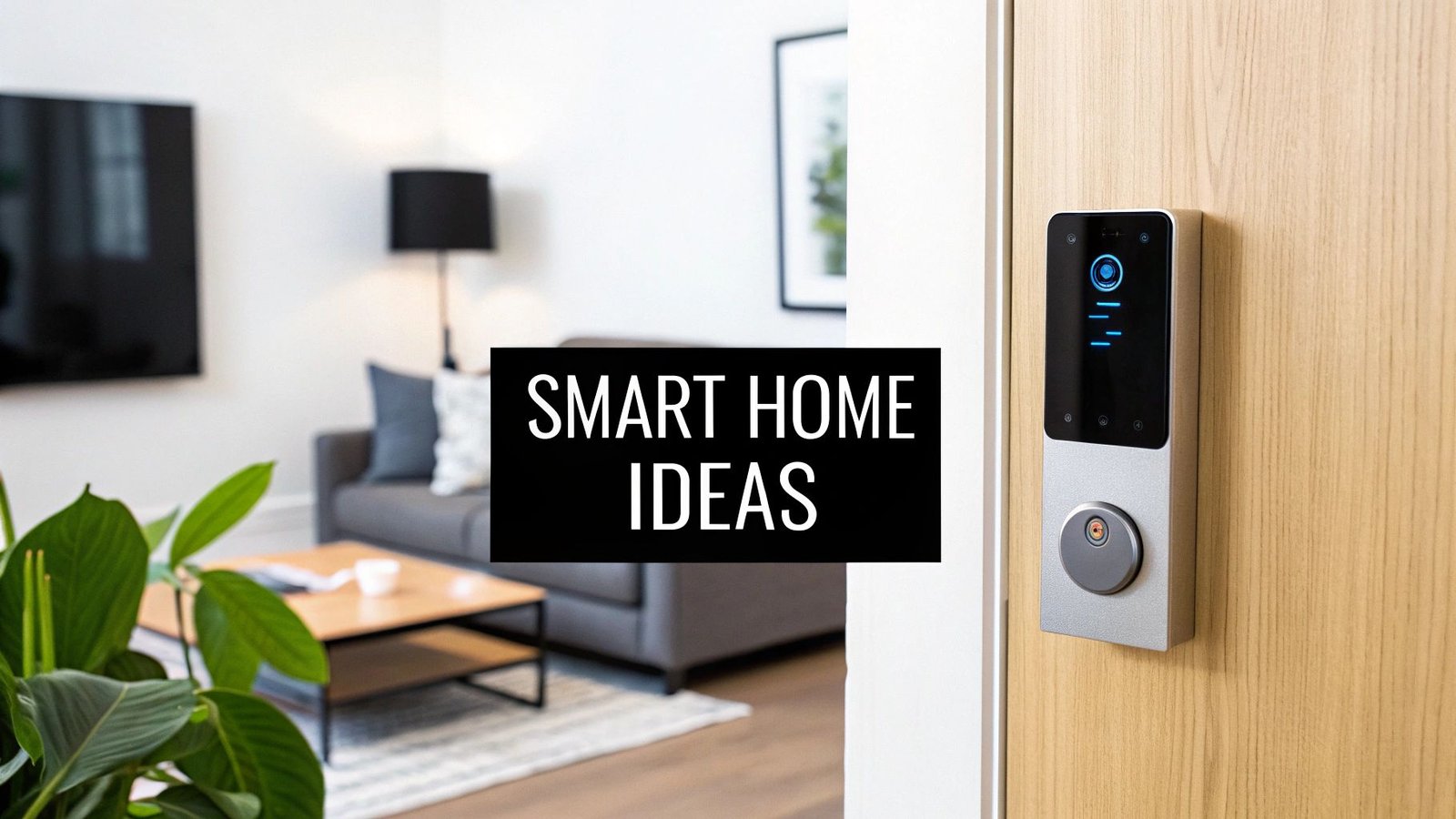

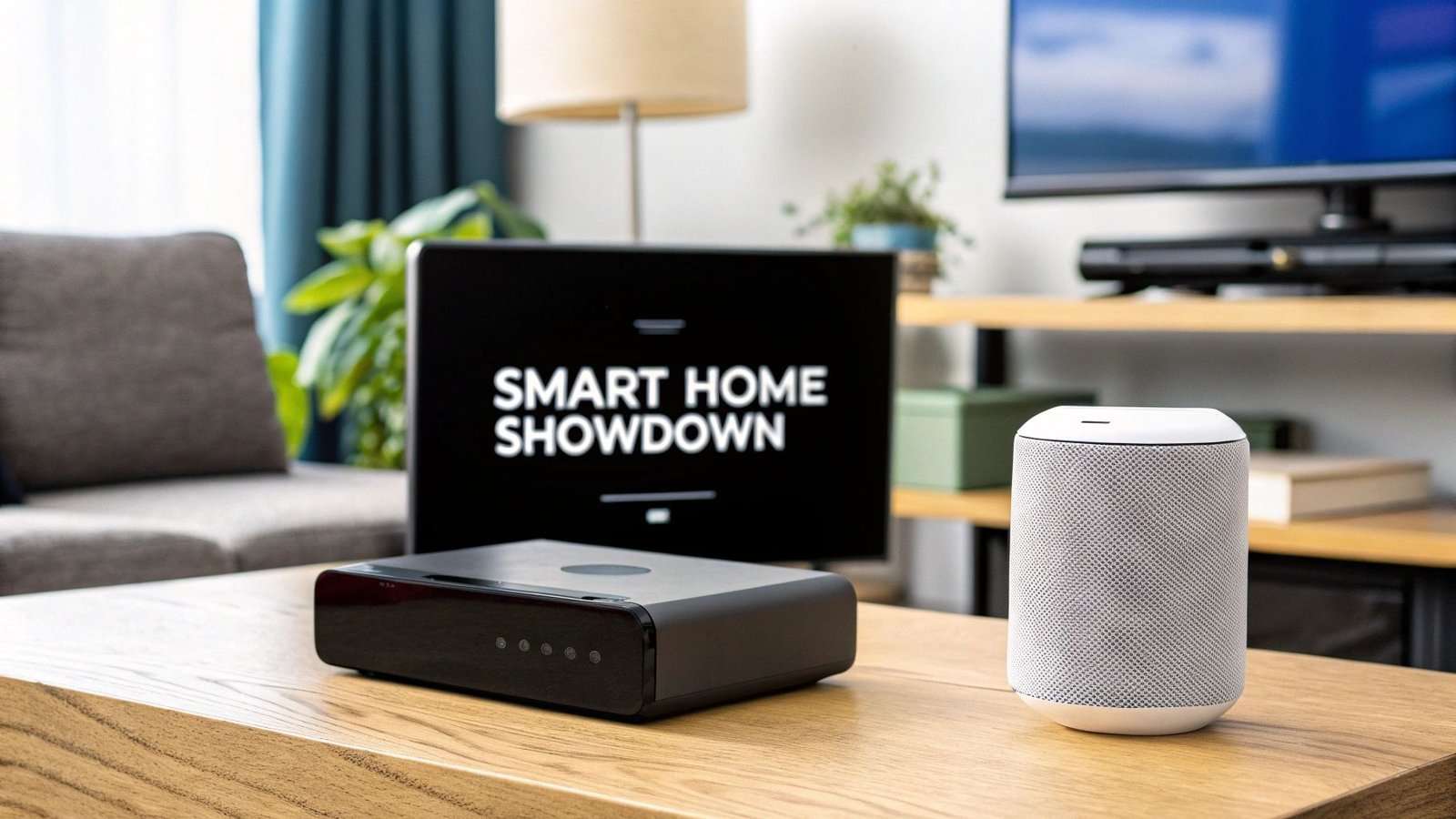


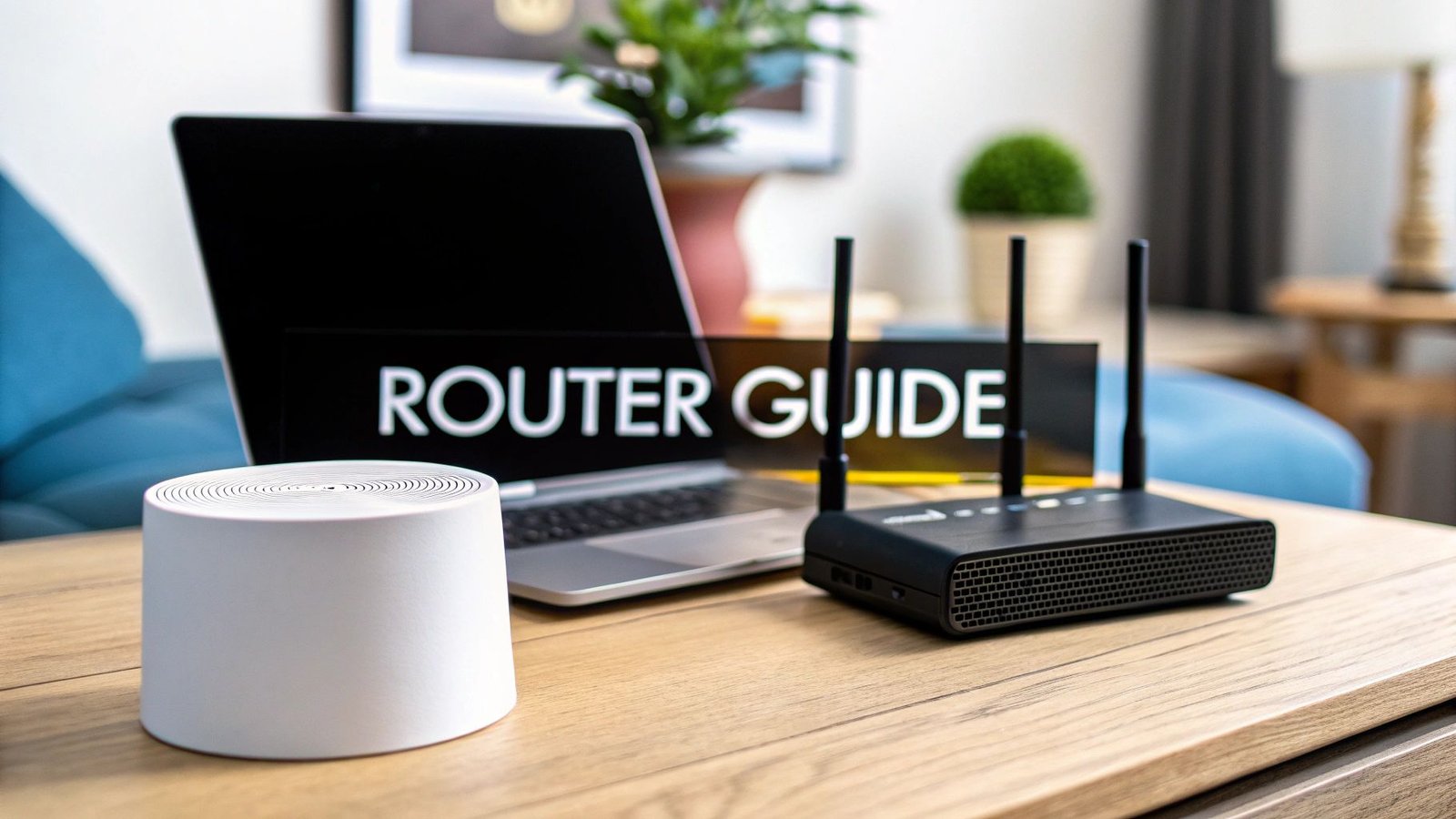
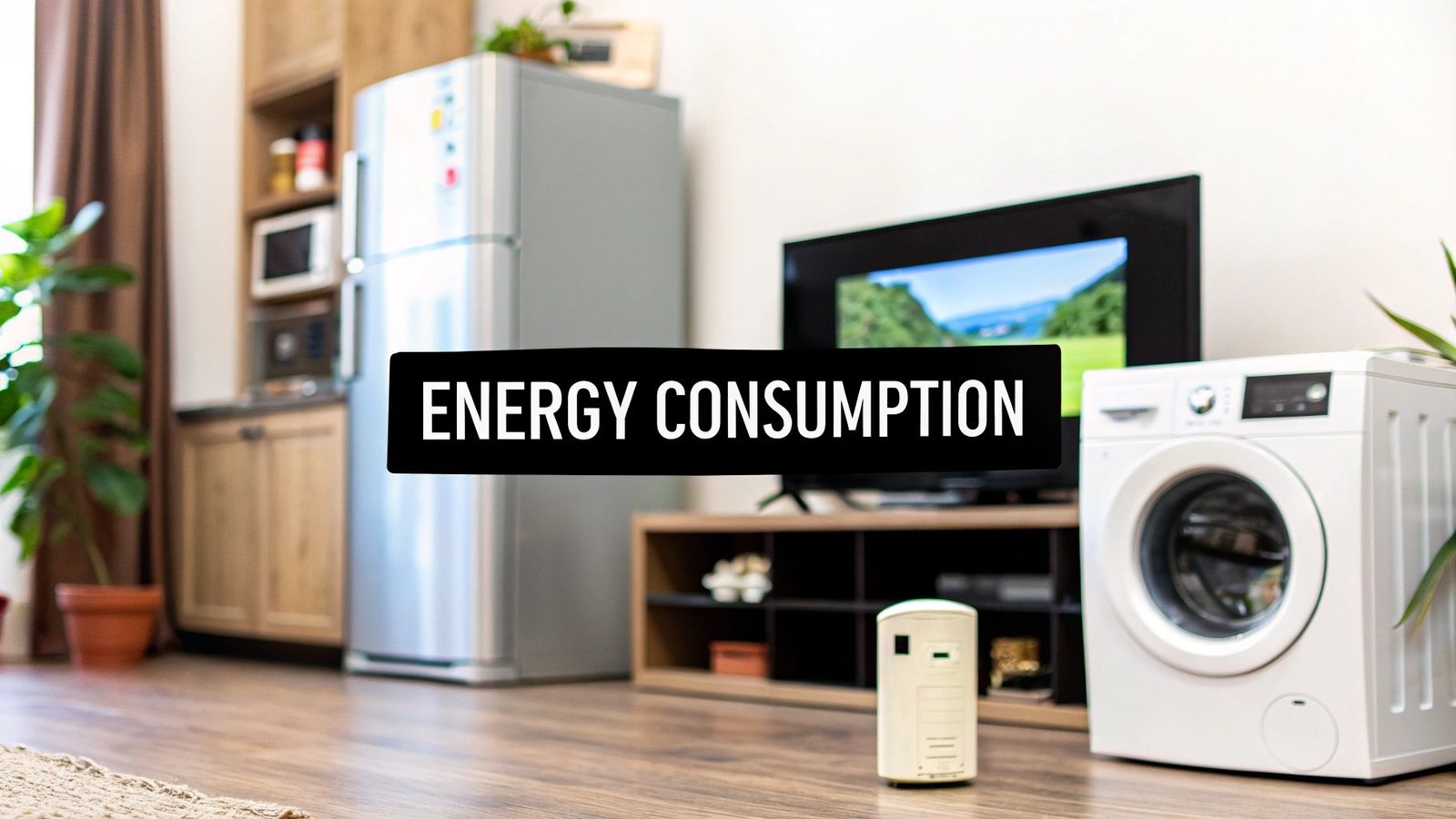
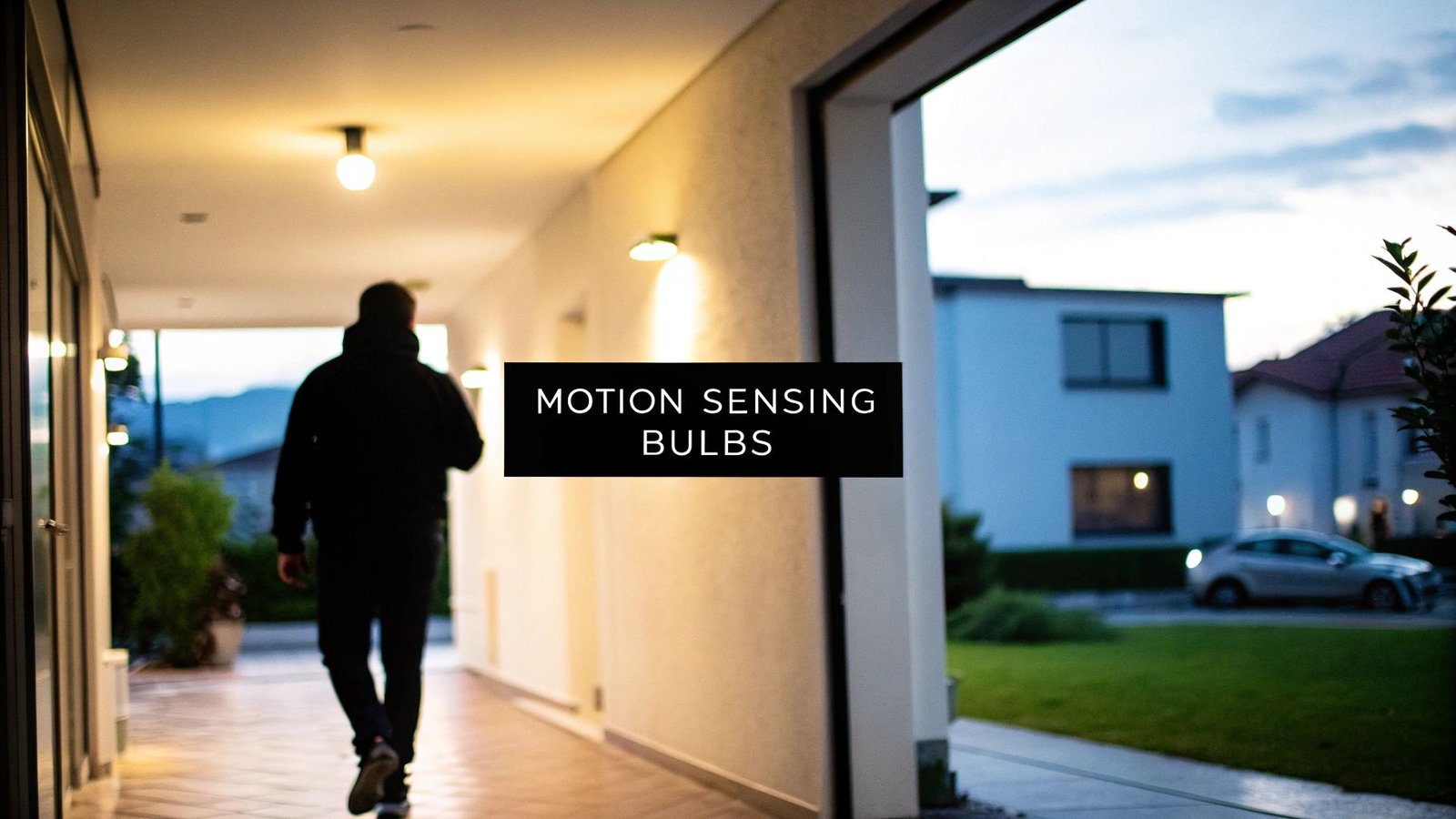
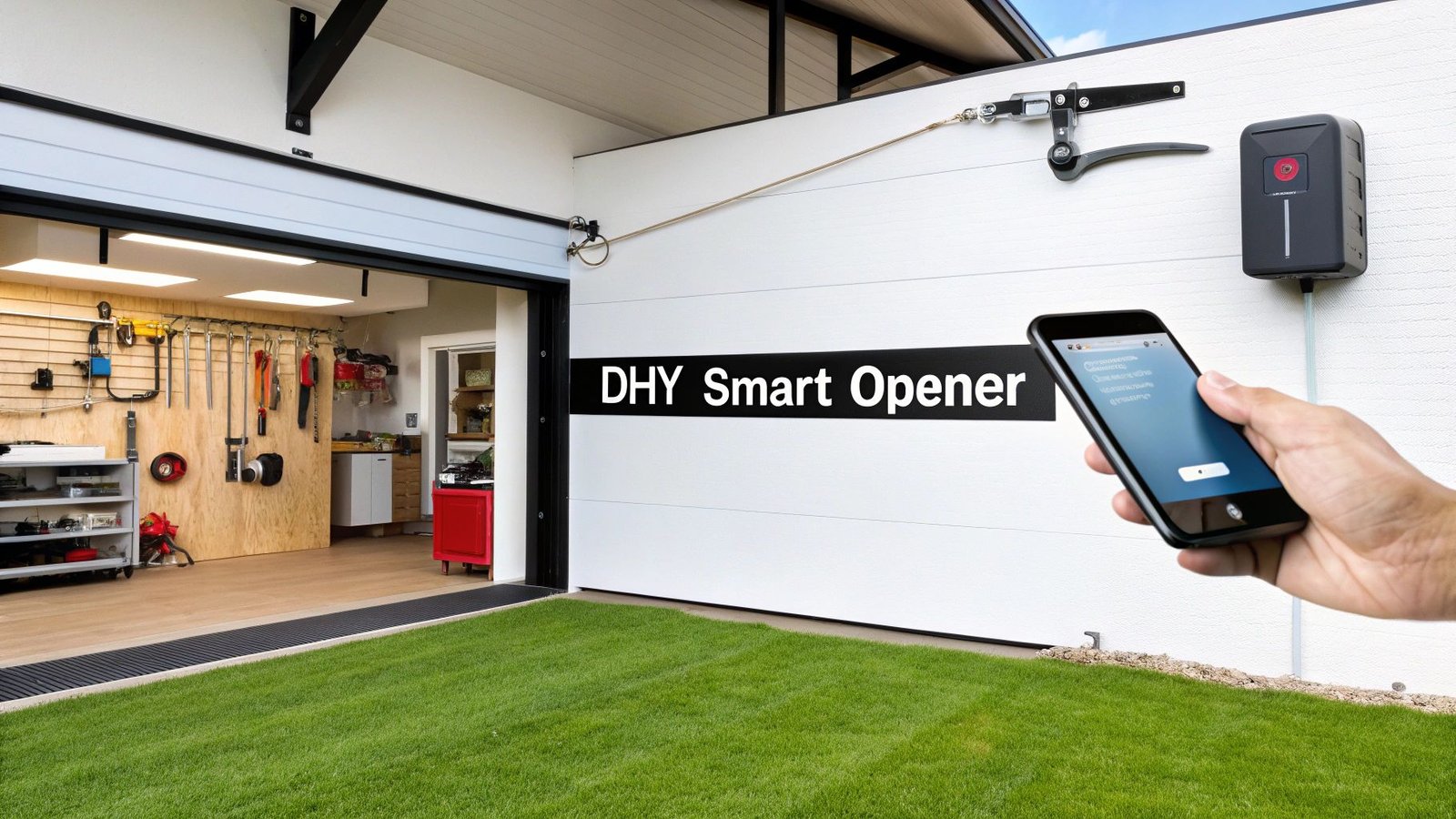
Leave a Reply